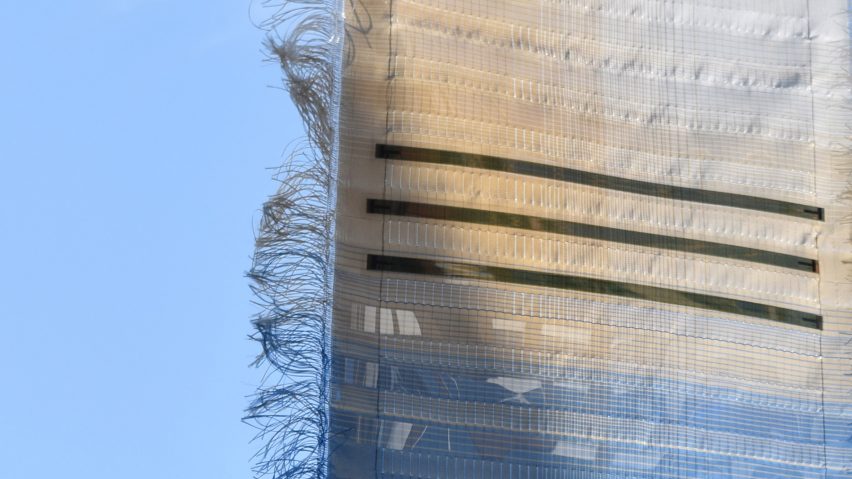Dutch designer Pauline van Dongen has unveiled a vision to "reupholster our built environment" using a solar-energy-generating textile she is developing with manufacturer Tentech.
Suntex is a durable and water-resistant solar textile that could be used to clad entire buildings, turning them into huge solar-energy generators.
"Whole facades could be dressed in this fabric," said Van Dongen. "We could create a completely new aesthetic for buildings."
Van Dongen presented the Tentech collaboration at The Solar Seminar, which took place at Het Nieuwe Instituut in Rotterdam on 9 September as part of The Solar Biennale that she and fellow designer Marjan van Aubel initiated.
The textile is created by weaving organic photovoltaic (OPV) solar cells, which are made from polymer, together with recycled polymer yarns.
Speaking to Dezeen, Van Dongen said a solar textile like Suntex offers a greater range of applications in architecture than typical photovoltaic panels.
It is flexible and lightweight, so could be used as a cladding material for new and retrofitted buildings. It could also be applied across glazing to provide solar shading.
"If you are retrofitting an existing building – whether that's a glass building or a concrete building – you can really give it a second skin with textiles," said Van Dongen.
"You can combine solar-shading properties with solar harvesting, and give buildings a completely new outer appearance."
Van Dongen claims that Suntex requires less embodied carbon to manufacture than many other building materials.
"It has a lower carbon footprint simply because it's lightweight," she said.
The textile can also be created in different colours and patterns, using recycled polymer yarns supplied by fabric producer Morssinkhof Sustainable Products.
For Dezeen's Solar Revolution series, Van Dongen and Van Aubel have penned an opinion column calling for new attitudes towards the possibilities of solar power.
Van Dongen has been exploring the possibilities of solar textiles for the past 10 years; she released her first solar project, the Wearable Solar Dress, in 2013.
Both this project and the Suntex textile feature in The Energy Show, an exhibition about solar energy at Het Nieuwe Instituut, which also forms part of The Solar Biennale.
Van Dongen told Dezeen that expanding her own work beyond wearables, into architecture, offers her greater scope to promote a switch to solar energy.
Tents, awnings, curtains, parasols and swimming pool covers are all products she believes could be produced in her Suntex textile.
The challenges, she explains, are in ensuring that the material can be manufactured to an appropriate level of durability and that it can be easily recycled.
There are also issues around the energy efficiency of so-called third-generation photovoltaics – which are what Van Dongen uses in her designs – compared with the rigid silicone that is typically used for photovoltaic panels.
However, Van Dongen believes that the wider benefits of solar textiles make them an attractive prospect for the future.
"I think it's important to see the whole package and look at it very holistically," she said.
"Maybe adding a textile can bring a new kind of experience and value to our buildings and environments."
Solar Revolution
This article is part of Dezeen's Solar Revolution series, which explores the varied and exciting possible uses of solar energy and how humans can fully harness the incredible power of the sun.

